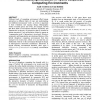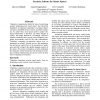ICCSA
2009
Springer
14 years 11 months ago
2009
Springer
A mobile agent is regarded as an attractive technology when developing distributed applications in mobile and ubiquitous computing environments. In this paper, we present ODDUGI, a...
MUM
2009
ACM
14 years 11 months ago
2009
ACM
Different kinds of computing environment effect human interaction in different kinds of ways and understanding how different environments ‘work’, as it were, is important to t...
PERCOM
2003
ACM
15 years 4 months ago
2003
ACM
Ubiquitous computing has fueled the idea of constructing sentient, information-rich "smart spaces" that extend the boundaries of traditional computing to encompass physi...
PERCOM
2004
ACM
15 years 4 months ago
2004
ACM
Ubiquitous computing environments accrete slowly over time rather than springing into existence all at once. Mechanisms are needed for incremental integration-the problem of how t...
PERCOM
2005
ACM
15 years 4 months ago
2005
ACM
This paper presents a world model for location-aware and user-aware services in ubiquitous computing environments. It can be dynamically organized like a tree based on geographica...
PERCOM
2007
ACM
15 years 4 months ago
2007
ACM
Most authentication protocols designed for ubiquitous computing environments try to solve the problem of intuitive, scalable, secure authentication of wireless communication. Due ...
CHI
2003
ACM
15 years 5 months ago
2003
ACM
The iStuff toolkit of physical devices, and the flexible software infrastructure to support it, were designed to simplify the exploration of novel interaction techniques in the po...
CHI
2005
ACM
15 years 5 months ago
2005
ACM
We present results of a study that considers (a) gestures outside the context of a specific implementation and (b) their use in supporting secondary, rather than primary tasks in ...
CHI
2007
ACM
15 years 5 months ago
2007
ACM
Physical controls such as knobs, sliders, and buttons are experiencing a revival as many computing systems progress from personal computing architectures towards ubiquitous comput...






